Story and photos by Troy A. Buzalsky
Adding to the typical checklist before any boating adventure should have the right tools in the toolbox to go along with fuel…check. Raingear…check. Lunch is packed…check. Fresh bait…check. Rods, reels and tackle…check. Ice in the kill bag…check. Batteries and electronics…check. Toilet paper…check. This is my typical pre-trip checklist that I mentally go through before I venture out onto my favorite waterway, be it a local river, the estuary, or the big blue.
Recently, our group was embarking on a weeklong upriver adventure that would take us nearly 30 miles through a boulder-infested river known for its ability to eat boats alive while offering exceptional fishing opportunities. Being somewhat of a thrill seeker, there’s something very satisfying when embarking on such a journey.
As all good game plans unfold, the upriver jaunt went spectacularly perfect considering the boat was way overloaded with camping gear, tackle, extra fuel, and necessary food and beverages to last a week in the wild.
Arriving at our sandbar, which would serve as our home base for the next seven days, we quickly unpacked, made camp, and geared up. With nightfall upon us we figured we had time to make a couple quick passes to see if we could wrangle up an evening fillet. As we approached the flat, the water looked fishy and the tailout looked inviting. As boat captain, I dropped the kicker motor, squeezed the fuel bulb, and fired her up. She quickly started as I let her idle on choke for approximately 30 seconds before I opened the choke and began to backtroll…At least that was the plan.
With the current pulling the boat downstream the little kicker sputtered and coughed, a sound that this motor has never made. The motor then died and would only start with the choke in the full position. Again, I let the choked motor idle momentarily, opened it up, only to find the motor unwilling to idle down and run smoothly. A few choice curse words were cast in the air, and I decided that an evening at the fire pit was in order.
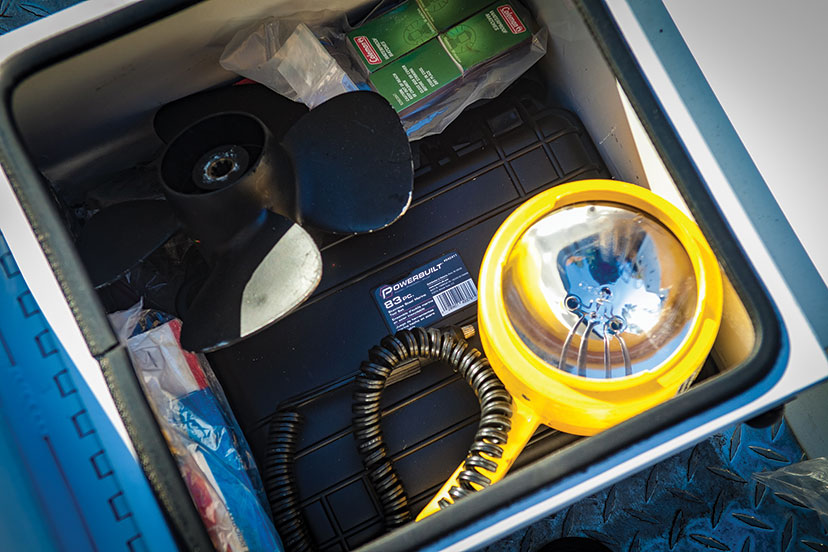
The Powerbuilt 83 Piece Stainless Steel Marine Tool Set’s toolbox features a rugged, waterproof case and is small and compact—perfect for storing in a seat box. Also found in this seat box is a fuel filter with wrench, spark plugs, spotlight, waterproof matches, duct tape, bailing wire, spare prop, and toilet paper.
With morning upon us I fired up a fresh pot of coffee and headed down the sandbar to start my morning troubleshooting. Stored under my seat base, I grabbed my homemade, thrown-together toolbox and proceeded to analyze the engine problems. Specifically, the engine would run, but would not idle down without dying unless fully choked, and then it ran rough. Targeting the low-hanging fruit, I decided to check my fuel filter, fuel/water separator, and spark plugs first.
The kicker motor is a Yamaha 9.9 hp with electric-start and auto-tilt and it had performed flawlessly for the last decade. I’ve changed its oil and serviced its outdrive regularly. The only issue I ever had was when a wasp built a nest inside the water-pump indicator hole, AKA “pee hole.” In the back of my mind I had to wonder if during that mishap it somehow overheated and scored a cylinder, but that didn’t seem reasonable with the symptoms I was experiencing.
Gaining access to the outboard’s fuel filter was easy, and the filter was held on with constant-tension hose clamps that could be opened with a pair of pliers, which I had in my makeshift toolbox. I attempted to slide the hose off the fuel-filter barb with no luck. With no utility knife in the toolbox, I grabbed my freshly sharpened fillet knife and removed the filter. I ran fuel through the filter and also backflushed it, finding no sediment or restriction. My brother-in-law, Bob, then handed me a can of CRC Brākleen, an item he had packed for his chainsaw. I used the Brākleen and again back flushed the fuel filter with the pressurized spray before reinstallation. Predictably, nothing changed.
Next, it was time to remove the fuel/water separator on the main fuel supply that served fuel to both motors. It seemed unlikely this was the source of my problem since the main motor was running fine, but again, I was going after the easy solutions first, and I had an extra fuel filter in the boat.
Having installed the fuel/water separator early in the season, I knew I had only put it on hand tight, just like I do my oil filters. As I went to unscrew the filter canister it seemed more than hand tight. As hard as I could grip and twist, I could not break the filter free, and as poor planning would have it, I did not have a fuel-filter wrench onboard.
Having dealt with this in my auto-mechanic days, I grabbed a screwdriver, drove it through the filter, and used the screwdriver’s handle as a lever to unscrew the canister. After installing the new fuel/water separator, again the kicker fired up on choke, and again died off choke.
It was starting to seem like a carburetor problem but checking the spark plugs was next on the list of easy tasks. As I rummaged through my sockets, I had a full collection of metric and American, standard and deep well, but did not have a spark-plug socket. We dug through my brother-in-law’s chainsaw box and found his spark plug wrench, which unfortunately did not fit the boat’s spark plugs. I had to laugh at myself at this point. I had a full set of extra spark plugs for the big motor and the kicker, but I did not have a tool in the toolbox that would facilitate changing them.
Reluctantly, the carburetor was next. As I examined the carburetor there were no low-idle adjustments, simply an idle-speed adjustment and a choke adjustment. This meant that I would not be able to tune the carburetor, and the only thing I could do was remove it and attempt to service it on our remote sandbar, inconveniently located far from civilization.
Having rebuilt plenty of carburetors in my life, I wasn’t worried about the disassembly and reassembly, but I was concerned about the possibility of O-rings and/or gaskets that might be necessary for a successful field servicing. With my quarter-inch socket set, I pulled out a 10 mm socket and it fit perfectly on the carburetor bolts that held it to the intake manifold. However, I could only access the outside bolt. The inside mounting bolt would require a swivel head for my socket, and that was something that I did not have in my ratchet set. Luckily, I did have a very small, 10 mm end wrench, and when placed carefully over the top of the bolt head, while using a pair of vise grips, I could microscopically turn the head of the carburetor bolt in approximately 1/64-inch increments. This single bolt took nearly 15 minutes to remove and patience became a virtue.
The carburetor was not a complicated device and I was able to quickly access the float bowl. Methodically, I removed the main jet and the pilot jet. I removed every screw, and removed the float, which was installed with a drive pin…a royal pain in the tailpipe. As I examined the carburetor and liberally applied Brākleen to and through every crack, crevice and orifice, I could see that there was an additional jet deeply screwed inside the carburetor housing. Sadly, I had no screwdriver in my toolbox that would access the jet. My only possibility of cleaning it would be with our trusty can of Brākleen.
Once thoroughly cleaned, I reassembled and reinstalled the carburetor, prayed for a Hail Mary, and fired up the kicker motor. Nothing changed; it still would not idle down. Scratching my head, I was convinced that the low-idle jet was plugged, and somehow, I needed to find a way to access and clean it. Again, painstakingly removing the carburetor, I disassembled it and stared deep into the carburetor housing. About then my brother-in-law says, “Hey, I wonder if my Leatherman has a screwdriver that would fit.” As luck would have, his trusty all-purpose Leatherman had a small, narrow, flat screwdriver. “That just might work!” I exclaimed.
I inserted the flat screwdriver into the carburetor housing, and with a slight “Lefty Lucy” turn I felt the jet break loose and it easily unscrewed. As I inspected the jet it was quickly obvious that the main passage was plugged, the orifice barely thicker than a human hair. I attempted to blow through the jet with no success. I tried pressurized Brākleen, with no success. I scoured everywhere looking for a wire that might be small enough to unclog this jet. In the meantime, we tried everything we could find, including fishhooks, swivel wire, and even monofilament…no luck.
The problem was obvious, the solution not nearly as evident. My next thought was to consider boiling the jet to see if it would soften the clog. While we were debating, I kept going back to the Brākleen; more soaking and more pressurizing. And more soaking and more pressurizing. Suddenly I held the jet up in the air and I could see a pinhole of light! It was hard to believe something so simple could be so delightful! Now confident that the problem was solved, the carburetor was reassembled and reinstalled, and the kicker motor fired up. It purred like a kitten.
Ask any professional mechanic and they will tell you that their tools are their blood, and in many cases an inseparable force. However, it is almost impossible to have a complete tool set. You will always want or need one more tool to make your toolbox complete. Tools are not just tools, and the quality, and in some cases, performance, will differ from one manufacturer to the other. In the marine environment, quality matters more than for that home-based, hobbyist mechanic who has a hardware store just down the street.
The above story is just one of countless examples of why a toolbox is not only a good idea for your boat, but why a well-thought-out toolbox is vital. This column will not hand select what tools you need in your toolbox, but if nothing else, it will make you reflect on things you might want to consider having along for the ride. Your day on the water, or your extended journey, might just include the travel companion Murphy, who’s always trying to prove that if there’s a possibility of several things going wrong, the one that will cause the most grief will be the one to go wrong.
Marine Matters
Remember, this is a marine/boat tool set designed to be stored and used when on the water, not necessarily in the shop. This means the tools should be designed to be highly rust and corrosion resistant, possibly even made from stainless steel. Marine-specific tools generally have a higher percentage of chromium to form a protective layer of oxide on the tools. It’s amazing how quickly water, especially salt water, can eat through steel without chromium. For this reason, marine-specific hand tools are sometimes harder to find and tend to cost more than regular tools.
Tools vs Tool Kits
I’m a big believer that pre-packaged, multi-piece tool kits are a good place to start, but in no way are they the end-all, be-all toolbox for most marine applications. If you Google “Marine Tool Kits” you will get an assortment of sets ranging from 30 to 300 pieces. Most of these inexpensive sets are “No-name” brands and do not offer specifications or information on their overall quality.
If you dig deep in your search engine you will find larger and more comprehensive sets, some that even include waterproof cases and die-cut foam to keep the tools orderly and rattle free. One such kit is the Powerbuilt 83-piece Stainless Steel Marine Tool Set. It comes in a heavy-duty, compact waterproof case that is 13” x 11” x 5”. This size fits perfectly under my boat’s seat boxes.
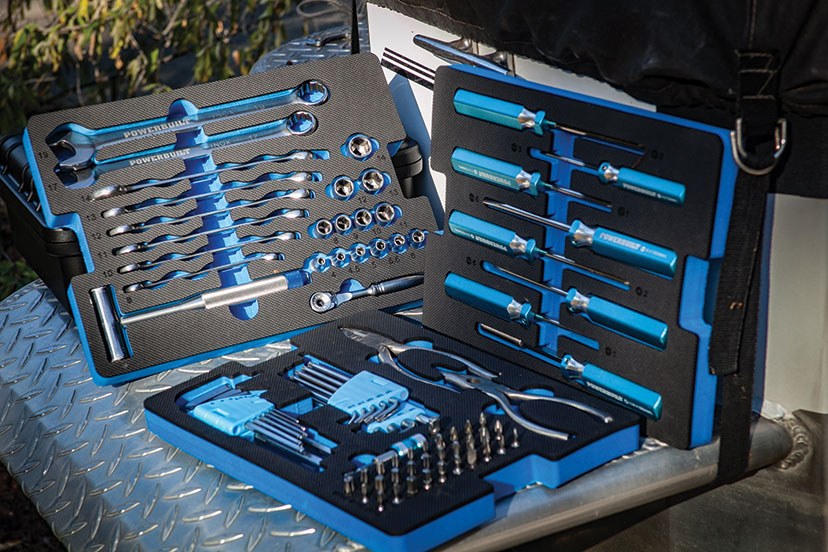
The Powerbuilt 83 Piece Stainless Steel Marine Tool Set is small and compact, yet versatile. It features die-cut foam to hold the tools and eliminate rattle, and the tools are extremely high quality. As the author says, they are so nice you’d expect to see them used in the operating room.
The Powerbuilt kit is clearly made for marine use. All tools are made from 420J2 stainless steel and the set is divided into three well-organized trays. The top tray holds a total of seven screwdrivers: three Phillips, three slotted and a nut-driver. The driver grips are precision-machined anodized stainless (not plastic), and they look like they could be used in an operating room. They are that nice.
The second layer in the die-cut foam includes a set of stainless, metric, combination end wrenches from 8 mm to 19 mm, a small mallet, and a complete ¼” metric ratchet and socket set. The sockets are all six-point, designed to contact the head of a fastener well away from the corners so contact is made on the thickest part of the fastener. This dramatically reduces the likelihood of slippage and rounding of the corners. Translation: less stripping, and less frustration.
The bottom tray contains lineman’s and needle-nose pliers, a set of Allen and Torx key wrenches, and a variety of ¼” hex bits to fit the nut driver or ratchet. Small in size, yet smart in design, the Powerbuilt Stainless Steel Marine Tool Set is a great place to start.
American vs Metric, and everything in between
It’s a fact of life. We live in an internationally Americanized world, and because of this, there is no standard for hardware and/or tools, especially since most boats have parts and accessories from all over the world.
That bolt or nut might be a 10 mm metric or a 3/8” American, but it’s one or the other, not either. That screw might be a slotted, or a Phillips…or a hex, square, or even a Torx, and none are interchangeable. What about the lug nuts on the tow vehicle and the trailer? They could be 17 mm, 19 mm, 21 mm, 22 mm, 23 mm, or 3/4”, 13/16”, or 7/8”.
Because of these variables, it’s essential that when configuring your toolbox, you have a good idea of the specific types of tools you might need, because removing the alternator might require American sizes, while servicing the steering cable might require metric sizes. Let’s look at some tools you should consider when configuring your marine toolbox.
Wrenches
There are a wide variety of wrenches available for today’s mechanically inclined including fixed and adjustable styles. Fixed wrenches come as open ended, box end, and combination in style. To keep your wrench-count minimal, consider an open-ended set. If space and budget allow, combination wrenches (open end on one end, box end on the other end) are nice as they offer greater flexibility in use. Fixed wrenches are also available in a stubby version which can prove extremely helpful in tight spaces. Consider wrenches from 5/16” to 3/4” American or 8 mm to 19 mm metric.
Gear-headed wrenches, also known as ratcheting box-ended wrenches, are popular amongst mechanics, but unless you’re purchasing a high-end gear wrench, the marine environment might not be ideal.
Adjustable wrenches, also known as “crescent wrenches,” are very practical in many mechanical situations and offer flexibility when jumping between sizes, and from metric to American.
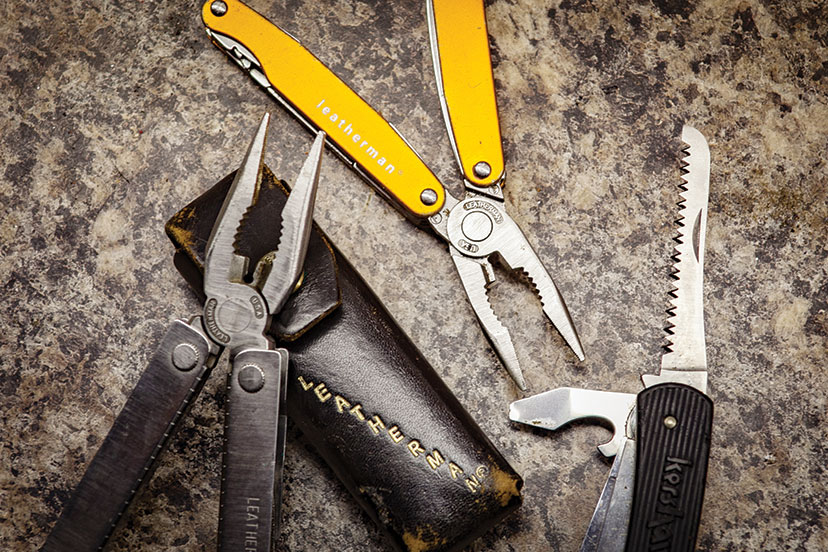
As the author found, sometimes a multi-purpose tool, like the Leatherman, has value as a handy and versatile tool.
Pliers
Slip-joint pliers are what most people would refer to as an ordinary pair of pliers. Although useful, they don’t get high marks for an essential tool, especially if you have other styles of pliers onboard. Most fishing boats already have one or multiple sets of needle-nose pliers, and if so, slip-joint pliers could be omitted from your toolbox.
Lineman’s Pliers are an electrician-styled plier that feature a flat nose, flat gripping surface, and inboard wire cutters. When working on a boat’s electrical system these pliers are an asset in your hand.
Diagonal Pliers are actually wire cutters and prove to be a perfect marine tool with endless applications from cutting wire and nylon straps, to cutting through fuel and vacuum lines. These are also perfect for cutting fishhooks, especially hooks buried into and through the skin.
Vise Grips
Vise grips are the quintessential jack-of-all-tools and a master of none. Many times, the vise grip is that perfect tool for getting the job done, and no marine tool kit should be without at least one pair. I find the small-sized vise grip is an excellent choice, and if you look hard, you can find them in stainless steel.
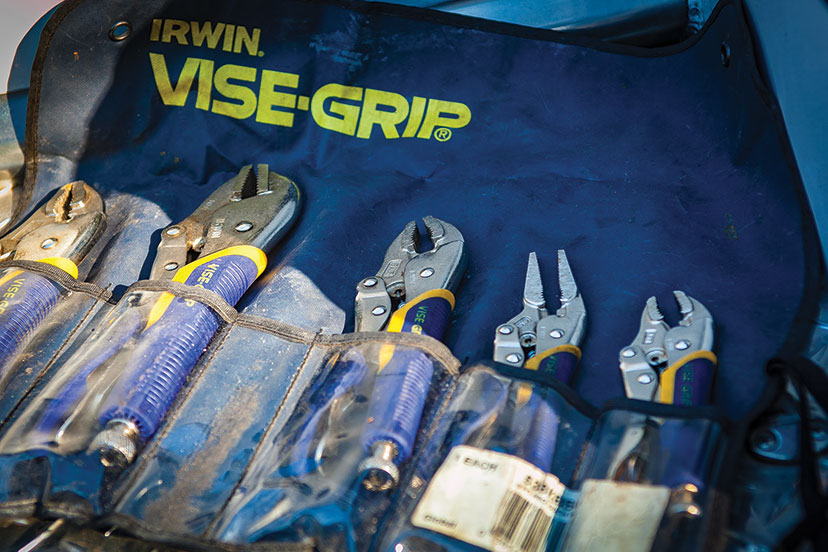
The vise grip-style pliers are that one tool everyone should have in their toolbox, and although not perfect for everything, they are perfect for some applications.
Screw Drivers
An assortment of screwdrivers is an essential part of any toolbox, and quality matters when selecting the best screwdrivers. Low-quality screwdrivers might be soft and easily deformed under stress. Size of the head and length of the shaft both matter when selecting the best screwdriver for the job. Both flat- and Phillips-style screwdrivers should be in your kit, and consideration should be given for specialty heads, like the square, Allen, and Torx style.
Ratchet-and-Socket set
A ratchet-and-socket set is an excellent item to have available, sometimes turning a dauntingly slow task into a simple and efficient procedure. Like the wrench sizes, a comprehensive set including extensions and a swivel head can prove useful. If I were selecting one set, it would a 1/4”-drive set as most field repairs can be accommodated with a smaller set. When space allows, a 3/8” set is nice, and a 1/2” set is great for large jobs, though such jobs are not typically undertaken while afloat. Don’t forget that spark-plug socket, and remember, spark plugs can be 5/8”, 3/4”, 13/16”, or 18 mm!
Prop Wrench
During the adventure I documented above, I noted that I was carrying a spare prop, yet I did not have a prop wrench to facilitate its removal and replacement. A typical prop requires a 1 1/16” prop wrench, but here again, make sure your wrench fits your prop, and make sure the main motor and the kicker motor both use the same-sized wrench. If not, have a prop wrench for each.
Filter Wrench
It’s been said there’s more than one way to skin a cat, and there’s also more than one way to remove a canister-style fuel filter. A cinch-type filter wrench is the most common, but others include three-jaw adjustable wrenches, and filter end-cap wrenches. Regardless, if you have a canister fuel filter, make sure you carry a spare filter and a way to remove and replace it in the field.
Wire Cutter/Stripper
Electrical trouble can be a frustrating problem for any mechanic and having basic electrical tools can help save the day. Electrical cutters/strippers, along with wire crimps, connections, and electrical tape are all part of a basic, electrical repair kit. Don’t forget fuses, again in the style and size applicable to your boat’s needs. I carry fishing crimping pliers for crimping fishing sleeves and making leaders. These serve as my onboard electrical pliers, and the sleeves can be used for an emergency electrical repair.
Utility Knife
Although a boat’s fillet knife might work in a pinch, consider adding a utility knife to your boat’s toolbox, because you never know when it might come in handy. Be sure it’s made of corrosion-resistant materials.

Although a utility knife is nice to have, sometimes you can use a fillet knife as that perfect cross-over tool in the toolbox.
Headlamp and/or flashlight
It’s often overlooked, and in some cases, one of the most practical items to help facilitate repairs. A quality headlamp or flashlight is truly an essential item and can turn a challenging job into a less tenuous situation. Recently, I purchased a Mantus Waterproof Rechargeable Headlamp, and I can say with certainty, it’s the best headlamp I have ever used, and now part of my boat’s essential items. A headlamp is generally more versatile than a flashlight as it allows use of both hands, yet it can also be removed and placed where needed if the beam doesn’t illuminate what you need to see while it’s on your head.
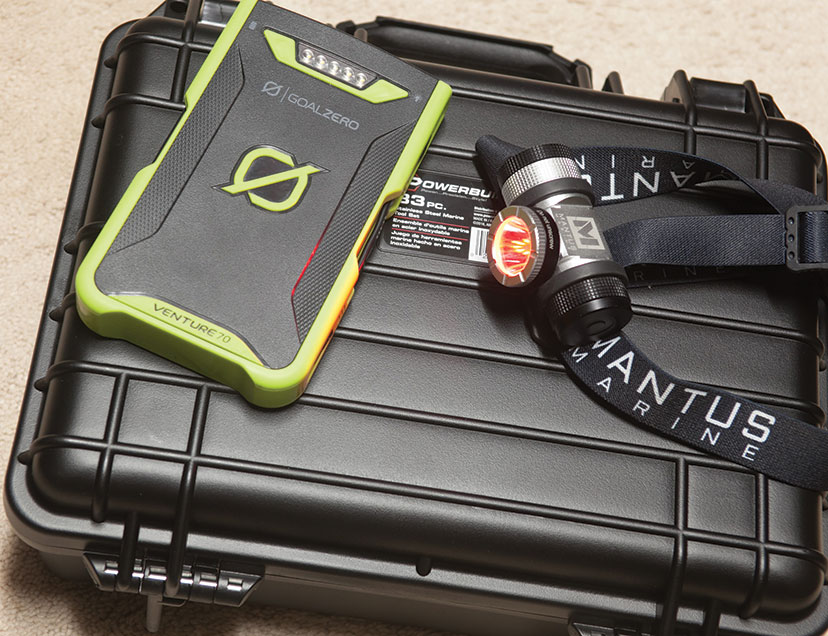
The Mantus Headlight is that perfect boater’s headlamp! It’s waterproof, bright, durable, rechargeable, and perfect for a marine toolbox.
Bailing Wire, Duct Tape, and Nylon Strap Ties
Because I run a heavy-gauge, welded-aluminum jet boat, and because hitting rocks is just part of the whitewater adventure, I carry a repair kit that includes sheet aluminum, silicone, a Yankee drill/screwdriver, drill bits, pop rivets, pop-rivet gun, duct tape, and bailing wire. The hope is, if I ever hit hard and take on water, I can make a quick-and-dirty field repair. So far, I’ve been lucky and haven’t needed it. But as Captain Edward A. Murphy Jr., famous for Murphy’s Law declared, “Whatever can go wrong, will go wrong,” generally at exactly the wrong time; thus the reason for a well thought-out toolbox.
Troy Buzalsky is the Boats columnist for Fish Alaska magazine and writes feature stories based on his Alaska adventures. He can be reached at troybuz@comcast.net.
